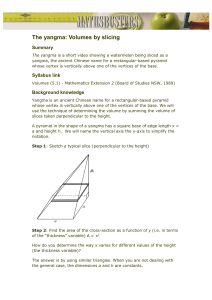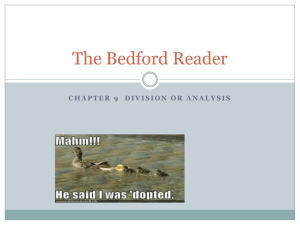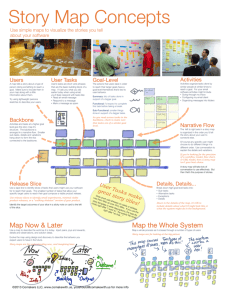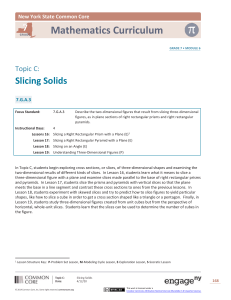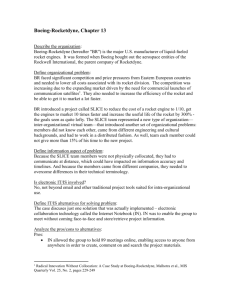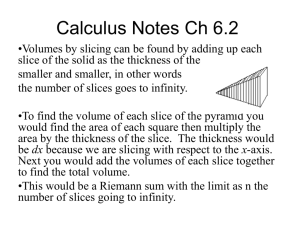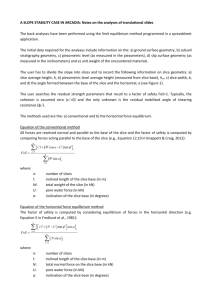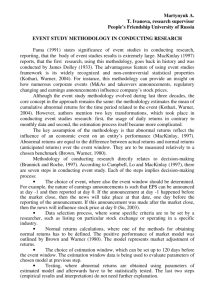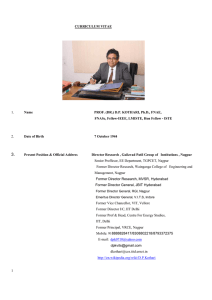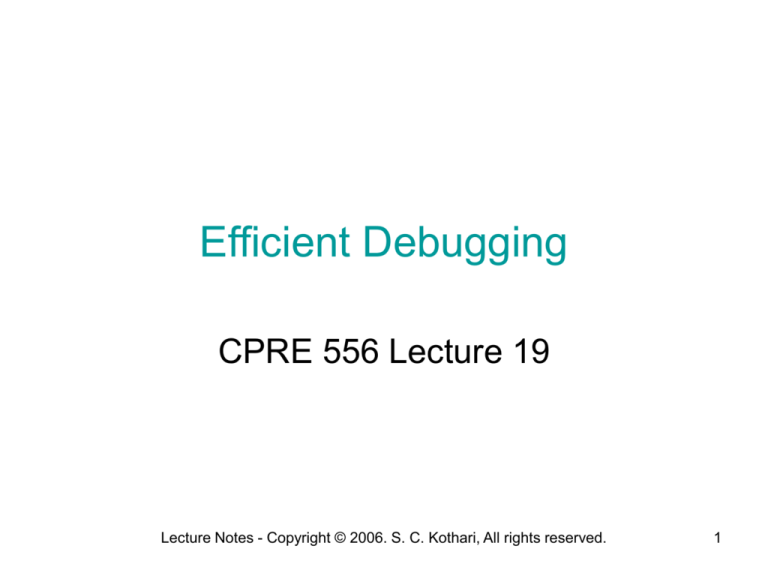
Efficient Debugging
CPRE 556 Lecture 19
Lecture Notes - Copyright © 2006. S. C. Kothari, All rights reserved.
1
Contents
•
•
•
•
•
Debugging challenge
Use of program slicing
Static vs. dynamic slicing
Reaching definitions
Program slice browser
Lecture Notes - Copyright © 2006. S. C. Kothari, All rights reserved.
2
Debugging Challenge
• Debugging is a complex and difficult
activity.
• The failure may be manifested far away
from the fault (bug) itself.
• Analysis is needed determine the cause
and the location of a program failure.
• Analysis is often tedious and time
consuming because of many
dependencies and many execution paths
Lecture Notes - Copyright © 2006. S. C. Kothari, All rights reserved.
3
Sample Program
• The program computes the sum of the areas of
N triangles.
• It reads the value of N, followed by the lengths of
the three sides of each of these N triangles.
• It classifies each triangle as an equilateral,
isosceles, right, or a scalene triangle. Then it
computes the area of the triangle using an
appropriate formula.
• Finally, the program prints the sum of the areas.
Lecture Notes - Copyright © 2006. S. C. Kothari, All rights reserved.
4
Lecture Notes - Copyright © 2006. S. C. Kothari, All rights reserved.
5
Start Debugging
• Suppose this program is executed for the
test case #1 when N = 2 and sides of the
two triangles are (5, 4, 3) and (4, 4, 2)
respectively.
• If the final sum of areas printed is
incorrect, how should we go about locating
the bug in the program?
Lecture Notes - Copyright © 2006. S. C. Kothari, All rights reserved.
6
Many Possibilities for Bugs
• Looking backwards from the printf
statement on line 46, there are several
possibilities:
– sum is not being updated properly
– one or more of the formulas for computing the
area of a triangle are incorrect
– the triangle is being classified incorrectly
– the values for the three sides of the triangle
are not being read correctly.
Lecture Notes - Copyright © 2006. S. C. Kothari, All rights reserved.
7
Debugging Steps
1. Determine which statements in the code
have an influence on the value of sum at
line 46.
2. Select one (or more) of these statements
at which to examine the program state.
3. Recreate the program state at those
statements to examine specific variables.
Lecture Notes - Copyright © 2006. S. C. Kothari, All rights reserved.
8
Program Slicing
• It is used to find all those statements in a
program that directly or indirectly affect the
value of a given variable occurrence
(variable name and statement location).
• The statements that affect the value
constitute the slice of the program with
respect to the given variable occurrence
Lecture Notes - Copyright © 2006. S. C. Kothari, All rights reserved.
9
Two Types of Program Slices
• Two types of slices: static and dynamic.
• A static slice includes all statements that
could influence the value of a variable
occurrence for all possible inputs to the
program.
• A dynamic slice includes only those
statements that influence the value of a
variable occurrence for a given test case.
Lecture Notes - Copyright © 2006. S. C. Kothari, All rights reserved.
10
Data vs. Control Slices
• A data slice is one that is defined with respect to
a data value—a variable occurrence.
– Useful when we are trying to determine the source of
a wrong value for a variable occurrence.
• A control slice is one that is defined with respect
to control reaching a certain program location.
– Useful when we are trying to determine why the
control has reached a wrong location.
Lecture Notes - Copyright © 2006. S. C. Kothari, All rights reserved.
11
Reaching Definitions
• Looking at the whole slice at once may be
overwhelming.
• It may be useful to analyze the interstatement program dependencies one at a
time – incremental slicing.
• Reaching definitions are the assignments
(or modifications) of variables that reach
and affect the given variable occurrence.
Lecture Notes - Copyright © 2006. S. C. Kothari, All rights reserved.
12
Terminology
• Def: a definition of a variable x is a statement
that assigns a value to x
• Use: a use of a variable x is a statement that
reads the value of x
• Kill: a definition of a variable x on a path is said
to be killed on a control flow path if we encounter
another definition of variable.
• Reaches: a definition d reaches a point p if
there is a path from the point immediately
following d to p - such that d is not killed along p.
Lecture Notes - Copyright © 2006. S. C. Kothari, All rights reserved.
13
Example
1: I := M - 2;
2: J := N;
3: A:= U1;
4:
5: DO
6:
I := I +1;
7:
J := J-1;
8:
if (E1) then
9:
A:= A + 2;
10: else
11:
I := u3;
12: endif
13: WHILE e2
• def of A at 3 and 9
• The definition at line 9 kills
the definition of A from line 3
• The definition of A from line 3
reaches line 9
Lecture Notes - Copyright © 2006. S. C. Kothari, All rights reserved.
14
Program Slice Browser
• We developed a program slice browser
(PSB) to provide the user a visual
representation of the slice.
• Using the PSB:
– A slice can be viewed at different levels of
granularity: statements, control blocks, and
procedures.
– By coupling the visual representation and the
corresponding source one can conveniently
navigate through the code.
Lecture Notes - Copyright © 2006. S. C. Kothari, All rights reserved.
15
References
• Efficient debugging with slicing and
backtracking:
http://www2.umassd.edu/SWPI/slicing/pur
due/TR80P.pdf
• Program slice browser:
http://doi.ieeecomputersociety.org/10.1109
/WPC.2001.921713
•
Lecture Notes - Copyright © 2006. S. C. Kothari, All rights reserved.
16


